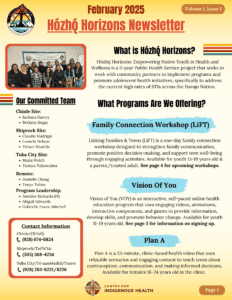
Project Summary
Native youth sexual and STI risk reduction programming continues to be one of the greatest needs across Navajo Nation. The University of Montana has partnered with Johns Hopkins Center for Indigenous Health to plan and implement evidence-based, youth pregnancy and sexually transmitted infection prevention strategies for Native youth on Navajo Nation.
Background information
- Despite national declines in teen birth rates, American Indian (AI) rates have not experienced similar declines and remain the highest of all ethnic groups in the US with 24.2 births per 1,000 adolescent girls – twice the national birth rate.
- Navajo Nation ranks above the national average on numerous measures of sexual risk, STIs and AI teen birth rates. Of particular concern, syphilis in one Navajo Nation county is approximately 10 times the national rate.
What we are doing
- We have engaged a Community Advisory Board and Youth Advisory Board to select an evidence-based program best suited for Navajo youth and guide design and implementation of the program.
- The target population is Navajo youth ages 10-19. Youth will receive the selected program through summer sports camps, school-based lessons, and clinics.
- We will train family health coaches from existing Center staff and additional hires from the community to implement the program.
How this will help improve health in our community
- The program will leverage community and cultural strengths to postpone sexual initiation, clearly communicate the risks and consequences associated with sex, and develop youth’s knowledge, attitudes, beliefs, and skills to make positive decisions as they move through adolescence.
- By providing trauma-informed and Positive Youth Development approaches to preventing unplanned pregnancies and STIs, youth will foster skills to avoid sexual risk before they become sexually active and help those who are sexually active return to healthier, reduced-risk choices in the future.
February 2025 Newsletter
